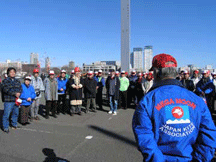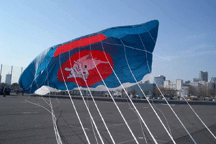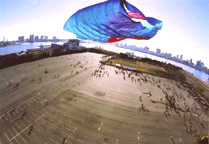Entries in Kiting in the News (36)
Breakaway Kites Can Pose Major Safety Hazard
A recent event with a breakaway kite clearly illustrates the danger that can occur when kites get loose and drift out of the control of the kite flyer.
A large box kite being flown on a 'braided plastic rope' line somehow broke away from some youngsters who were flying the kite in very gusty conditions in Shreveport, LA.
Having seen kites break their line on a number of occasions, I am always amazed at the path they can take, the distance they can travel and the serious mischief they can sometimes get into when they are out of the control of the flyer.
In this instance, the kite soared towards the runway of the Shreveport airport where CFI Kevin Morris (flight instructor) was taking off with his student pilot in a Cessna 150.
A VWeb, an Internet aviation magazine and news service, reported:

As Kevin looked up after a brief gauges check at about 500 feet MSL he saw the box kite looming. "No problem," Kevin told AVweb. "A big box kite is easy enough to evade." If only that was all there was to it. As he took the controls from his student pilot to maneuver around the kite the prop caught the rope, wrapping it up like a winch. A significant drop in power and severe vibrations followed, but Kevin was able to nurse the plane around to Runway 23 and set it down safely.
Although there was damage to the cowling and windshield of the plane, Kevin Morris managed a safe landing.
All of this reminds us of the need to fly safely. We often view our kites as mere things of beauty, simple devices that are under our total control. We can be lulled into lapses of caution when we fly because we have had a wide range of experience with kites.
Make no mistake about it - a breakaway kite can be a dangerous thing. It is not often that a kite line fouls an airplane propeller and almost causes a crash, but it is easy to imagine a breakaway kite drifting down on a roadway creating a major distraction for drivers or luring a young child into harm's way. There are frequent power outages in Pakistan, India, and other nations where loose kites cut in aerial dog fights are a regular occurrence. Such shorts and outages can happen here in North America as well. The summer 2005 edition of AKA's Kiting magazine has a dramatic photo of the mess created by the carbon filament rod frame of a kite when it landed on electrical supply lines cutting out power to a neighbourhood in the ensuing blackout.
So, CAUTION and SAFETY are necessary at all times. Be certain to use line with sufficient strength for the size of the kite and the wind condtions. Check your flying lines for wear and fraying. Check bridle points and attachments as well. Hours of flight time in the sun and wind can create wear and deterioration to your line, bridle and attachment points. Crossed lines with other flyers will create abrasions and nicks that can lead to a break when the line is under stress. Safety is a must and as responsible kite flyers we must exercise care and caution at all times.
Another frequent problem that I see at many flying events is the lack of forethought by kiters to have some proper equipment in use and in place to assist them when the wind suddenly comes up and creates control problems. Necessary items include:
- proper gloves to handle the hard pulling kite. Cuts, burns and abrasions are not only painful but can lead you to letting go of the line and creating a flyaway, out of control kite.
- ground stakes or anchors to tie your kite off if it starts to pull too hard. Several of these should be in place ready to use at a moment's notice. Indeed, some kites should only be launched after first being tied to a secure ground stake.
So, fly safely and be responsible!
Thanks to Carl Bigras of Ottawa, ON for the tip on this story.
Source article: "Killer Kite Stalks Shreveport Pilots" by Liz Swaine.
Supreme Court of Pakistan Lifts Kite Flying Ban for Fifteen Days
 Responding to several petitions to lift a ban on kite flight for the holiday period in Pakistan, the Supreme Court decided to temporarily permit kite flying for fifteen days. During this period, the activity will be monitored to determine if safety conditions have improved.
Responding to several petitions to lift a ban on kite flight for the holiday period in Pakistan, the Supreme Court decided to temporarily permit kite flying for fifteen days. During this period, the activity will be monitored to determine if safety conditions have improved.
Pakistan has been troubled by many serious kite injuries and even deaths of kite fliers during the Spring holiday periods. Most of this is due to two factors: -injuries sustained by the kite flyer during the flight of the kite (falling off roof tops, wandering into automobile traffic, etc.) and -injuries sustained from the glass and chemically coated kite lines used in kite fighting during the holiday periods. In addition, serious power blackouts causing economic disadvantage have been frequently caused by the kites and lines creating shorts in the power grid. Some kiters have also been electrocuted trying to rescue kites in power lines.
While the lifting of the ban on flying is temporary, the regulation against using glass coated line, known as Manja, remains in effect.
At the end of the fifteen day period the issue will again be revued by the Court.
From: The Daily Times - Lahore, Pakistan, Feb. 11, 2006
LAHORE: A full bench of the Supreme Court of Pakistan, headed by Chief Justice Iftikhar Mohammad Chaudhary, has allowed kite manufacturing and kite flying for 15 days throughout the country from February 25 to March 10.
The bench observed that kite flying with any dangerous material, including ‘Manja’, was not permitted.
The bench stipulated that all district nazims and administrative officials would fix the date for the ‘Jashan-e-Baharan’ (spring festival).
Flying kites with prohibited strings was declared to be an offence under section 4-A of the kite flying ordinance. The prohibited materials include manja, metallic wire, nylon cords and tandi.
The court also rejected a Punjab government ordinance which asked for kite manufacturing to be legalised one month before the ‘basant’ festival to allow for the production of kites and string for the event, saying that the whole process should be completed within the allotted 15 days, adding that no additional time would be given.
The court also directed all four provincial inspectors general of police to submit their reports of these fifteen days, and in case any deaths or untoward incidents occurred during this period, the court would re-examine the concessions granted by it.
The Supreme Court also held that from March 10, there would be a complete ban on kite flying and manufacturing.
The court also maintained that the responsibility for effectively implementing the court’s orders rested solely with the provincial governments, district nazims and police.
Previous postings on this topic are found within this blog:
Kite Ban Law Continues to Confound Pakistan
 In an effort to interpret the law banning the flying of kites with coated strings in Pakistan, the state of Punjab recently passed a law covering the manufacture and sale of kites and kite line that would require maunfacturers to register with the state. In addition, the ordinance permits kite flying under certain circumstances during a fifteen day period in the spring of each year.
In an effort to interpret the law banning the flying of kites with coated strings in Pakistan, the state of Punjab recently passed a law covering the manufacture and sale of kites and kite line that would require maunfacturers to register with the state. In addition, the ordinance permits kite flying under certain circumstances during a fifteen day period in the spring of each year.
On January 23, 2006, Geo TV of Pakistan reported:
LAHORE: Punjab Government has promulgated Punjab Prohibition of Kite flying (Amendment) Ordinance, 2006 which will come in to force immediately.
According to a press release issued by Government of Punjab, no person would be allowed to manufacture under the ordinance, sell or offer for sale metallic wire, nylon cord (tandi), any other thread coated with sharp maanjha or any other injurious material for the purpose of kite flying.
Violators of the Ordinance would be liable to imprisonment for 3 years or to a fine of Rs.40,000/- or both.
The Nazim of the concerned district, through a notification, issued with the prior approval of the government, could allow kite flying and sale of kites for a period not exceeding 15 days during the spring season in a year provided that kite manufacturing is allowed for such period as the government may specify by general or special order.
Every manufacturer, trader or seller of kites or kite flying materials will get himself registered with the concerned City District Government or the District Government in the manner as may be prescribed by the government through a notification.
However, this was immediately challenged the following day by the former Vice-President of the Supreme Court of Pakistan.
The Daily Times of Pakistan reported that Muhammad Ikram Chaudhry called the ordinance “contempt of court”, saying that it allows kite flying for a specific time in Punjab despite the fact that the Pakistan's highest court has imposed a countrywide ban on it. Chaudhry claimed that the ordinance was a “clear violation” of the ban and also contrary to Article 9 (Safety and Security of Citizens) of the Constitution.
Adding to the volatility of the issue was another major power outage in Lahore, Pakistan caused by kite flying that took place in spite of the Supreme Court ban on the activity. The Daily Times of Pakistan suggested that police seem to be able to do little to control the sport.
Kite flying is so deeply imbedded in the culture of Pakistan that one wonders how the situation will be resolved. The high cost of power outages, the accidents causing injury to kite fliers and bystanders, and the occasional death all make the issue a very complex one for the nation.
Kite flying in Pakistan is very different from that in North America, Europe, Australia and New Zealand. In these nations, kite flyers do not engage in battles to cut one another out of the sky. Whereas in Pakistan, the measure of kite flying skill is the ability to outmaneuvre an opponent and take his or her kite out of the sky by cutting the flying line.
This issue will take a long time to resolve and I anticipate that there will be additional postings on this matter.
The Flight of the Japanese Megakite
Photo sequences of the flight of the Japanese Megakite, the third version of the World's Largest Kite, have been posted. The news releases for the flight occurred today, January 15, 2006, but a photo record on the web site of the Japan Kite Association shows the correct date of the flight as January 8-9, 2006.
Thanks to Sharon Musto of Winnipeg, MB for drawing the photo links to my attention. Sharon is the Region 13 Representative of the American Kitefliers Association. Region 13 is the International zone, representing all kite fliers outside the United States.
- Megakite in Tokyo - photos by Masami Takakuwa & Katsutaka Murooka
- Kite World On-Line - 2006世界一の大凧揚げ 東京・晴海 1月8日~9日
Here are a few highlight photos, in reduced size, from the two photo sites.
A. Masaaki Modegi, President of the Japan Kite Association briefs "Japan's World's Largest Kite Team".
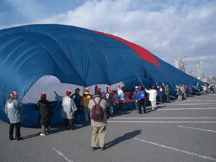 B. The Japanese version of the World's Largest Kite fills with air prior to flight.
B. The Japanese version of the World's Largest Kite fills with air prior to flight.
C.. The Japanese megakite takes flight.
D. Kite Aerial Photography view of Japanese version of World's Largest Kite, showing Tokyo skyline in the background.
Japan's Version of World's Largest Kite Takes Flight
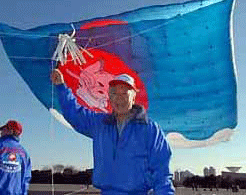 News media today (Jan. 15, 2006) reported that Masaaki Modegi, president of the Japan Kite Association and world renowned kite flyer, flew Japan's version of the world's largest kite on Jan. 8-9, 2006 at Harumi Pier in Tokyo's Chuo-ku. Assisted by a team of skilled kite fliers, the 25-metre by 40-metre (approx. 80 ft. x 132 ft.) kite flew at an altitude of 30 metres in a light breeze.
News media today (Jan. 15, 2006) reported that Masaaki Modegi, president of the Japan Kite Association and world renowned kite flyer, flew Japan's version of the world's largest kite on Jan. 8-9, 2006 at Harumi Pier in Tokyo's Chuo-ku. Assisted by a team of skilled kite fliers, the 25-metre by 40-metre (approx. 80 ft. x 132 ft.) kite flew at an altitude of 30 metres in a light breeze.
The kite was completed in November last year by New Zealand kite designer Peter Lynn. This was it's inaugural flight. It is expected that the kite will be flown in a number of festivals in Japan during the coming months.
This is the third kite of this size making the Japanese version one of a trilogy of kites that claims the current title of World's Largest Kite. The other two kites are owned by Kuwait and David Gomberg of Gomberg Kite Productions in Neotsu, OR, representing the United States.
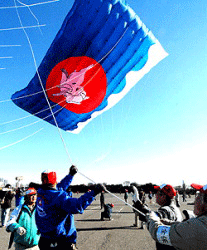 For more information on the world's largest kites visit my earlier Journal entry on this topic.
For more information on the world's largest kites visit my earlier Journal entry on this topic.
These kites are huge. They cover approximately 1.5 times the area of an NFL football field and require the application of stringent safety precautions to fly, generally at very low altitudes (typically around 30 metres).




